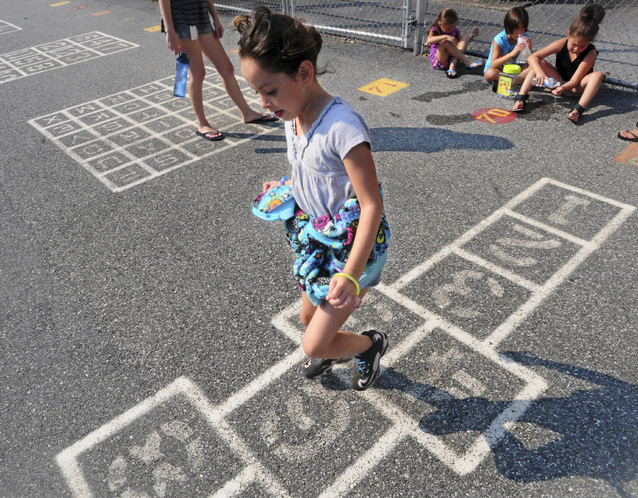Parents shouldn’t over worry about early issues with children’s knees and feet
Most early anomalies in a child’s gait will work themselves out, says Dr. Peter Nieman.
Childhood development can be a time of both excitement and stress. On the one hand, it is exciting for parents to document their baby’s progress. Who will forget that first smile or their first step?

Serenity Martinez plays hopscotch at Price Elementary School in Lancaster County, PA. Blaine T. Shahan, Lancaster Online
Dr. Peter Nieman, Calgary Herald January 11, 2018
But what if the parents notice that the first step is marked by a foot that turns in? And what if the toddler begins to stand and the feet are noticed to be flat? Or what negative thoughts pop up when the child’s knees are too far apart — or too close?
Intoeing, knock-knees, bowed legs, flat feet are all too common in the first few years of a child’s life. It can really upset some parents who are worried, not just about cosmetic appearances, but also about the child’s future as an athlete.
When a baby has a forefoot that turns in at birth, it is called metatarsus adductus. This typically is due to pressure on the foot when the baby was still in the womb. It occurs in one in 5,000 births and usually is flexible — unlike a clubbed-foot where the deformity is fixed. This condition is more common in twins and in males. The foot has a curved appearance. The vast majority of patients with this condition will get better on their own. Meanwhile, experts suggest gentle stretching exercises be done frequently throughout the day, such as with each diaper change or feeding.
Intoeing is the most common parental concern regarding how children walk. Nearly two in 1,000 children have an intoeing gait and it is usually bilateral.
When intoeing is due to internal tibial torsion, the tibia turns inward in and it may be noticed at birth due to having been in the confined space of the womb. After birth, the tibia gradually turns out and aligns properly. In toddlers aged one to four years, a foot turns in due to the tibia turning it inward. The child may be described as clumsy or tripping on his or her own feet while walking. It may become more obvious with fatigue or fussiness.
The knees point straight when the child walks, but the feet turn inward. The good news is that most cases resolve on their own by school age and that there is no need for bracing the legs. Surgery is considered only after eight years in severe cases when functioning is impaired.
Another cause of intoeing is when the hips rotate inward and the child appears to have “kissing knees when walking. (The knees bump into each other when the child walks). These children typically prefer to sit in the W position.
Most cases resolve by age 10 and no bracing is needed. Some parents have been told to discourage the child from sitting in the W position, but this makes no difference to the outcome — the child should be allowed to sit in whatever position they find most comfortable.
Many famous athletes, such as Michael Jordan, Andre Aggasi and John Elway, never outgrew their intoeing. In sports where quick acceleration is required for success, this condition may, in fact, be beneficial.
When the legs are bowed so that the knees are far apart it is considered physiological in the first 12 months of life. The legs begin to straighten out as the child grows and, in many cases, by age 18 months, one can already see improvement. By age four, most of these patients experience complete resolution.
Genu valgum (knock knees) presents after age two. The distance between the ankles is very wide (the normal is eight centimetres) as a result and children often complain that they cannot stand with ankles together, because the knees get in the way. Up to 75 per cent of children aged three to five have knock knees and 95 per cent will self-resolve by age seven.
Flat feet occur in 40 per cent of children aged three to six. A weak arch is the most common cause and as the child grows the arch develops up to age eight. Thus, observation is in order while we wait for the arch to mature.
When a child with flat feet stands on the tip of their toes the arch can be seen and the feet are not flat anymore. Another “trick” to confirm that there is no need to worry is to push the big toe backwards and upwards. Doing this test, known as the Jack toe raise test, reveals an arch and abolishes a flat foot.
The use of orthotics, shoe inserts, special shoes and exercises do not stimulate arch development. However, they can provide support and comfort.
The good news is that many fears are proven over time to be unfounded. Many patients simply need to be followed conservatively. As Voltaire once said, “Sometimes a doctor’s task is to entertain the patient while the illness runs it’s course.”
| Dr. Nieman is a community-based pediatrician, author of Moving Forward and a life coach. For more information, see http://www.drnieman.com |
 Source Calgary Herald
Source Calgary Herald
Also see
Get the kids to play games, unwired in Lancaster Online
